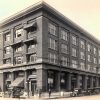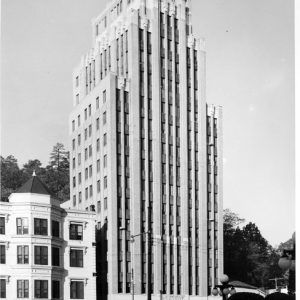calsfoundation@cals.org
Medical Arts Building
The sixteen-story Medical Arts Building at 236 Central Avenue in downtown Hot Springs (Garland County) was the tallest building in Arkansas from its completion in 1930 until 1960, when the Tower Building was completed in downtown Little Rock (Pulaski County). (The tallest building in Arkansas currently is the forty-story Metropolitan Tower in Little Rock, which was built in 1986.) The upper floors of the Medical Arts Building are now vacant. The Historic Preservation Alliance of Arkansas (HPAA) listed it in 2012 as one of the state’s most endangered places.
The Medical Arts Building was constructed by general contractor G. C. Gordon Walker with work beginning on December 1, 1929. Investors from Little Rock and New Orleans, Louisiana, purchased the site, which had been occupied by the Rector Bath House, from the Rector estate of St. Louis, Missouri. The Rector family had obtained the property from the federal government in 1893.
The Medical Arts Building was designed by the Little Rock architectural firm Almand & Stuck, which also designed Little Rock’s Central High School. It has long been recognized as one of the top Art Deco skyscrapers in the southern United States. Bas-relief limestone carvings on the frieze and on the facing of the main entrance are among the building’s notable features, along with the bronze grille work above the doors. A September 1930 article in the Sentinel-Record declared, “The structure as it stands is one of the most imposing buildings in Arkansas and a valuable addition to the business district of Hot Springs.”
The brick and reinforced concrete structure cost $375,000 to build. Tall ceilings and large windows were designed to help keep the building cool in the summer. Corridors featured terrazzo floors and Arkansas marble wainscoting. Two brass-trimmed elevators were run by uniformed operators in the building’s early days. A 1932 Arkansas Gazette feature noted that the elevators were equipped with telephones that could be used while the elevators were in motion.
The building was advertised as the “Skyscraper of Health” and eventually housed fifty-five physicians and five commercial businesses. When the building opened, the first floor was home to a florist and Martin Eisele’s Medical Arts Drug Store. The drugstore, which had been established in 1875, was the city’s oldest. Eisele renamed it the Colonial Drug Store and moved to a new location in September 1930. The fifth floor housed a medical and pathological laboratory. Lower floors generally housed six medical offices each. There were fewer offices on the upper floors because the building narrowed. The fifteenth floor housed a medical library and Dr. Earl McWherter’s dental offices from 1946 to 1968.
The building was placed on the National Register of Historic Places in 1978, three years after it was purchased from the Medical Arts Realty Co. by Richard Shofstall’s Styro Products Inc. of St. Louis. In January 1979, building manager Connie Tapanna told the Sentinel-Record, “There seems to be a certain feeling, an attachment for the building itself that frankly amazes me.” However, by the mid-1980s, the building was mostly vacant. Dr. George Fotioo, who began his medical practice in the building in 1945, was the last physician to leave the Medical Arts Building, in 1991. He closed his downtown office after receiving a notice to vacate from Freeling Properties, which represented Little Rock investor Melvyn Bell, who had purchased the middle thirteen floors of the building. Robert LiMandri, whose father had moved his tailoring business into the Medical Arts Building in 1976, also was evicted at that time. Bell had purchased all but the ground floor and the top two floors in September 1986. He shut off electricity and water to the thirteen floors he owned after experiencing financial problems.
In placing the building on its list of most endangered places, the HPAA stated, “The structure is Art Deco and due to the fineness of its massing and detail, it is the most significant structure of this style in the state of Arkansas.” The building’s latest owner, Marshall Coffman of Coffman Investment Inc. of Little Rock, told the Sentinel-Record in June 2012 that the building “absolutely” will not be torn down. Other major, historic buildings that are vacant in downtown Hot Springs include the former Majestic Hotel and former DeSoto Hotel.
In May 2021, it was announced that Trilochan LLC, a subsidiary of VIPA Hospitality, had purchased fifteen of the sixteen floors of the Medical Arts Building for redevelopment.
For additional information:
Friedman, Mark. “High-Rise Dispute.” Arkansas Business, November 25—December 1, 2024, pp. 6–7. Online at https://www.arkansasbusiness.com/article/hot-springs-medical-arts-building-lawsuit/ (accessed November 25, 2024).
“Medical Arts Building.” National Register of Historic Places nomination form. On file at Arkansas Historic Preservation Program, Little Rock, Arkansas.
Newsom, Jim. “Lots of Opportunities for State’s First Skyscraper.” Sentinel-Record, June 7, 2012, pp. 1A, 3A.
———. “State’s First Skyscraper on Endangered Building List.” Sentinel-Record, May 7, 2012, pp. 1–2A.
Robbins, Elizabeth. “Skyscraper of Health.” On The Go, March 2010, pp. 30–31.
Steed, Stephen. “15 Floors of 1930 Spa City Site Sell.” Arkansas Democrat-Gazette, May 6, 2021, pp. 1D, 4D. Online at https://www.arkansasonline.com/news/2021/may/06/15-floors-of-1930-spa-city-site-sell/?business (accessed January 31, 2024).
Rex Nelson
Arkansas’ Independent Colleges & Universities









Comments
No comments on this entry yet.